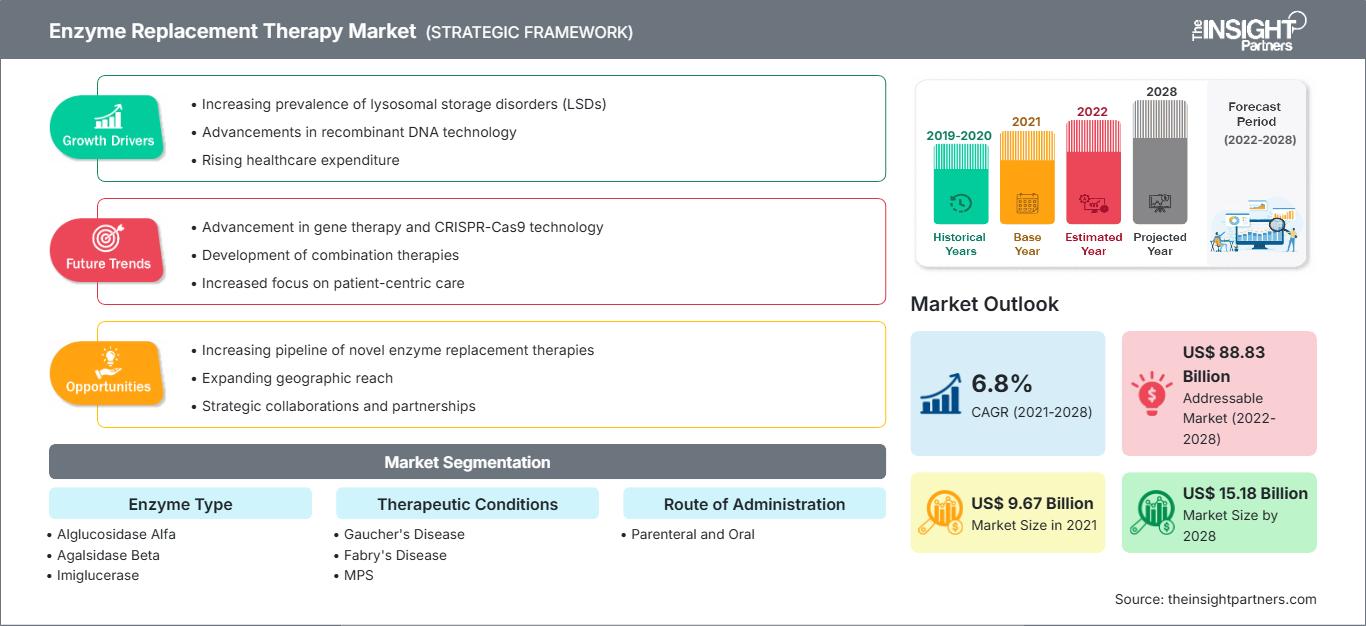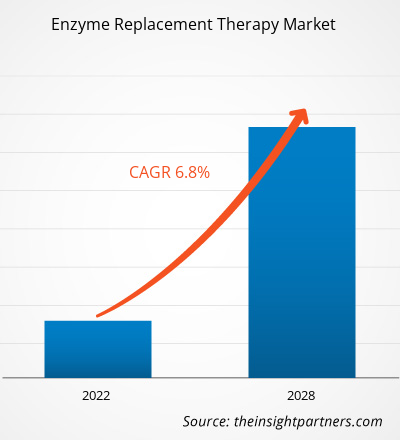Der Markt für Enzymersatztherapien soll von 9.673,39 Millionen US-Dollar im Jahr 2021 auf 15.184,70 Millionen US-Dollar im Jahr 2028 wachsen; von 2022 bis 2028 wird mit einer durchschnittlichen jährlichen Wachstumsrate von 6,8 % gerechnet.
Die Enzymersatztherapie (ERT) wird zur Behandlung angeborener Enzymmängel durchgeführt, wobei Enzyme oder Proteine mit enzymatischer Aktivität eingesetzt werden. Tierische, menschliche und rekombinant hergestellte Enzyme sind einige der für die Behandlung benötigten Enzymquellen. Die Therapie wird im Allgemeinen bei seltenen und lysosomalen Speicherkrankheiten angewendet, darunter Morbus Pompe, Morbus Fabry, Morbus Gaucher, Morbus Tay-Sachs und das Hurler-Syndrom. Die gebräuchlichste ERT-Methode sind intravenöse Infusionen, bei denen das Ersatzenzym über eine kontrollierte Infusion direkt in die Blutbahn verabreicht wird. Das Wachstum des globalen Marktes für Enzymersatztherapien wird auf die steigende Prävalenz lysosomaler Speicherkrankheiten (LSDs) und die schnelle behördliche Zulassung mit weiteren Vermarktungsvorteilen für Medikamente mit Orphan-Drug-Status zurückgeführt. Der erbitterte Wettbewerb unter den Marktteilnehmern behindert jedoch das Marktwachstum.
Der Bericht bietet Einblicke und eine detaillierte Analyse des globalen Marktes für Enzymersatztherapien und hebt verschiedene Parameter hervor, darunter Markttrends, technologische Fortschritte, Marktdynamik und eine Analyse der Wettbewerbslandschaft der weltweit führenden Marktteilnehmer. Er berücksichtigt auch die Auswirkungen der COVID-19-Pandemie auf den Markt in allen Regionen. Aufgrund der COVID-19-Pandemie konzentrierten sich viele Gesundheitsbehörden auf die pandemiebedingte Versorgung. Darüber hinaus verpassten im März 2020 viele Patienten, die eine Enzymersatztherapie benötigten, ihre Infusionen aufgrund unzureichender Krankenhausversorgung im Umgang mit COVID-19-Patienten. Patienten, die eine ERT benötigten, gaben an, bei Krankenhausaufenthalten oder in Bezug auf die Medikamentenversorgung Angst zu haben. Studien zeigten außerdem, dass einige Patienten unter Depressionen und verstärkter Angst litten. Daher wurden geplante Sitzungen zur Enzymersatztherapie (ERT) während der COVID-19-Pandemie unterbrochen, was sich negativ auf den Markt auswirkte.
Passen Sie diesen Bericht Ihren Anforderungen an
Sie erhalten kostenlos Anpassungen an jedem Bericht, einschließlich Teilen dieses Berichts oder einer Analyse auf Länderebene, eines Excel-Datenpakets sowie tolle Angebote und Rabatte für Start-ups und Universitäten.
Markt für Enzymersatztherapien: Strategische Einblicke

-
Holen Sie sich die wichtigsten Markttrends aus diesem Bericht.Dieses KOSTENLOSE Beispiel umfasst Datenanalysen, die von Markttrends bis hin zu Schätzungen und Prognosen reichen.
Geografische Einblicke
Geografisch ist der globale Markt für Enzymersatztherapien in Nordamerika (USA, Kanada und Mexiko), Europa (Frankreich, Deutschland, Großbritannien, Spanien, Italien und das übrige Europa), den asiatisch-pazifischen Raum (China, Indien, Japan, Australien, Südkorea und der restliche Asien-Pazifik-Raum), den Nahen Osten und Afrika (Saudi-Arabien, die Vereinigten Arabischen Emirate, Südafrika und der restliche Nahe Osten und Afrika) sowie Süd- und Mittelamerika (Brasilien, Argentinien und der restliche Süd- und Mittelamerika) unterteilt.
Markteinblicke
Steigende Prävalenz lysosomaler Speicherkrankheiten (LSDs)
Ein Lysosom ist ein membrangebundenes Zellorganell, das Verdauungsenzyme enthält. Ein Lysosom ist der zentrale zelluläre Knotenpunkt für den Abbau, das Recycling und die Signalübertragung von Makromolekülen. Jeder Defekt dieser Funktionen führt zur Ansammlung oder Speicherung von Makromolekülen in Lysosomen und damit zu Zellschäden. Die Hauptursache für lysosomale Speicherkrankheiten (LSD) sind Mutationen in den Genen, die für die Kodierung eines lysosomalen Enzyms verantwortlich sind. Darüber hinaus sind LSD ein angeborener Stoffwechselfehler, der zum Fehlen oder Mangel eines Enzyms führt. Säuglinge und Kinder sind stärker betroffen als Erwachsene, da sie das defekte Gen von einem oder beiden Elternteilen erben können. Seit dem letzten Jahrzehnt hat sich dieses Muster jedoch geändert und LSD treten häufiger bei Erwachsenen auf.
Darüber hinaus umfasst LSD etwa 70 Krankheiten, darunter Morbus Gaucher, Morbus Niemann-Pick, Morbus Fabry, Morbus Tay-Sachs, Mukopolysaccharidosen (MPS) und Morbus Pompe. Diese Erkrankungen sind einzeln selten, aber insgesamt sind sie deutlich verbreitet und betreffen 1 von 5.000 Lebendgeburten. In vielen Ländern wurden Erhebungen durchgeführt, um das Prävalenzmuster zu verstehen. Die Gesamtprävalenz stieg an. So wurde beispielsweise in The Lancet Regional Health eine Studie mit dem Titel „Prävalenz lysosomaler Speicherkrankheiten in Australien von 2009 bis 2020“ veröffentlicht. Die Studie ergab folgende Ergebnisse:
- Die Prävalenz in der australischen Bevölkerung ist 1,6-mal höher (1 pro 4.800 Lebendgeburten) als die gemeldete Prävalenz im Jahr 1996 (1 pro 7.700 Lebendgeburten).
- Morbus Fabry war mit 34 % aller Diagnosen (bis 2020) am weitesten verbreitet.
- LSDs kommen im Erwachsenenalter häufiger vor als im Kindesalter.
Die steigende Prävalenz von LSDs und die begrenzten Therapien zur Heilung der Krankheit treiben daher das Wachstum des globalen Marktes für Enzymersatztherapien voran.
Erkenntnisse auf Basis von Enzymtypen
Basierend auf dem Enzymtyp ist der globale Markt für Enzymersatztherapien in Alglucosidase alfa, Agalsidase beta, Imiglucerase, Idursulfase, Galsulfase und Velaglucerase unterteilt. alfa und andere Enzyme. Im Jahr 2021 hatte das Segment der anderen Enzyme den größten Marktanteil. Für dasselbe Segment wird von 2022 bis 2028 die höchste CAGR des Marktes erwartet.
Erkenntnisse basierend auf therapeutischen Erkrankungen
Basierend auf den therapeutischen Erkrankungen ist der globale Markt für Enzymersatztherapien in Morbus Gaucher, Morbus Fabry, Morbus Pompe, SCID, MPS und andere therapeutische Erkrankungen segmentiert. Das Segment Morbus Gaucher hatte im Jahr 2021 den größten Marktanteil und wird im Prognosezeitraum voraussichtlich die höchste CAGR verzeichnen.
Erkenntnisse basierend auf der Verabreichungsart
Basierend auf der Verabreichungsart ist der globale Markt für Enzymersatztherapien in parenterale und orale Verabreichung unterteilt. Das parenterale Segment hatte im Jahr 2021 einen größeren Marktanteil und wird im Prognosezeitraum voraussichtlich eine höhere CAGR verzeichnen.
Markt für Enzymersatztherapie
Die Analysten von The Insight Partners haben die regionalen Trends und Faktoren, die den Markt für Enzymersatztherapien im Prognosezeitraum beeinflussen, ausführlich erläutert. In diesem Abschnitt werden auch die Marktsegmente und die geografische Lage der Enzymersatztherapie in Nordamerika, Europa, im asiatisch-pazifischen Raum, im Nahen Osten und Afrika sowie in Süd- und Mittelamerika erörtert.Umfang des Marktberichts zur Enzymersatztherapie
| Berichtsattribut | Einzelheiten |
|---|---|
| Marktgröße in 2021 | US$ 9.67 Billion |
| Marktgröße nach 2028 | US$ 15.18 Billion |
| Globale CAGR (2021 - 2028) | 6.8% |
| Historische Daten | 2019-2020 |
| Prognosezeitraum | 2022-2028 |
| Abgedeckte Segmente |
By Enzymtyp
|
| Abgedeckte Regionen und Länder |
Nordamerika
|
| Marktführer und wichtige Unternehmensprofile |
|
Dichte der Marktteilnehmer im Bereich Enzymersatztherapie: Verständnis ihrer Auswirkungen auf die Geschäftsdynamik
Der Markt für Enzymersatztherapien wächst rasant. Die steigende Nachfrage der Endverbraucher ist auf Faktoren wie veränderte Verbraucherpräferenzen, technologische Fortschritte und ein stärkeres Bewusstsein für die Produktvorteile zurückzuführen. Mit der steigenden Nachfrage erweitern Unternehmen ihr Angebot, entwickeln Innovationen, um den Bedürfnissen der Verbraucher gerecht zu werden, und nutzen neue Trends, was das Marktwachstum weiter ankurbelt.

- Holen Sie sich die Markt für Enzymersatztherapien Übersicht der wichtigsten Akteure
Endnutzerbasierte Erkenntnisse
Basierend auf dem Endnutzer ist der globale Markt für Enzymersatztherapien in Krankenhäuser, Infusionszentren und andere segmentiert. Das Segment Krankenhäuser hatte 2021 den größten Marktanteil. Es wird jedoch erwartet, dass das Segment Infusionszentren im Prognosezeitraum die höchste durchschnittliche jährliche Wachstumsrate verzeichnet.
Die globalen Akteure auf dem Markt für Enzymersatztherapien verfolgen organische Strategien, einschließlich Produkteinführung und -erweiterung, um ihre Präsenz und ihr Produktportfolio weltweit zu erweitern und die wachsende Nachfrage zu decken. Einige wichtige Akteure, die zum Markt beitragen, sind Takeda Pharmaceutical Company Limited; Sanofi SA; AbbVie Inc.; BioMarin Pharmaceutical Inc.; Amicus Therapeutics; Alexion Pharmaceuticals, Inc. (AstraZeneca); Janssen Pharmaceuticals (Johnson & Johnson Services, Inc.); Recordati SpA; Pfizer Inc.; und CHIESI Farmaceutici SpA
- Historische Analyse (2 Jahre), Basisjahr, Prognose (7 Jahre) mit CAGR
- PEST- und SWOT-Analyse
- Marktgröße Wert/Volumen – Global, Regional, Land
- Branchen- und Wettbewerbslandschaft
- Excel-Datensatz
Aktuelle Berichte
Erfahrungsberichte
Grund zum Kauf
- Fundierte Entscheidungsfindung
- Marktdynamik verstehen
- Wettbewerbsanalyse
- Kundeneinblicke
- Marktprognosen
- Risikominimierung
- Strategische Planung
- Investitionsbegründung
- Identifizierung neuer Märkte
- Verbesserung von Marketingstrategien
- Steigerung der Betriebseffizienz
- Anpassung an regulatorische Trends






















 Kostenlose Probe anfordern für - Markt für Enzymersatztherapien
Kostenlose Probe anfordern für - Markt für Enzymersatztherapien